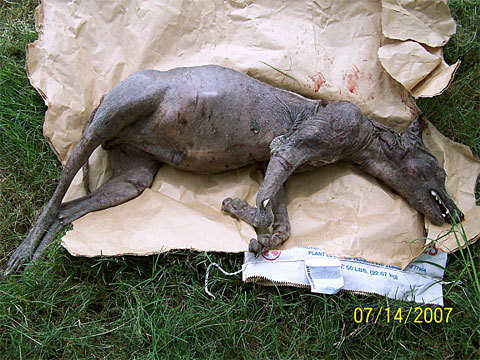Skip to comments.
Mystery monster returns home after 121 years [Montana][Cryptozoology][Shunka Warak'in]
Bozeman Daily Chronicle ^
| 15 Nov 2007
| Walt Williams
Posted on 11/15/2007 2:27:42 PM PST by BGHater
click here to read article
Navigation: use the links below to view more comments.
first previous 1-20, 21-40, 41-47 last
To: ZULU
Tasmanian Tiger or wolf kept coming up in my memory so I googled that and guess what?
The Thylacine, commonly known as the Tasmanian Tiger (due to its striped back), the Tasmanian Wolf is believed to have become extinct in the 1930s.
The pictures of it online sure looks like the description and although it would have been a long way from home, it was fairly common to have odd animals and freaks in traveling shows to amaze and delight rural Americans back in the 19th century.
It’s possible that a traveling circus or carney show might have lost one of the last of the breed somewhere in Montana.
I sent a copy of my information to the reporter in Montana. What fun! No old person should be without the internet to keep up their interest in life.
41
posted on
11/16/2007 5:09:24 PM PST
by
wildbill
To: sauron
Tasmanian Devil. The body build, some aspects of the coloration. Oddly similar.Yes, I saw that too.. the length and shape of the lower jaw.... kinda looks marsupial- Like a Taz tiger...
42
posted on
11/16/2007 5:11:41 PM PST
by
roamer_1
(Vote for FrudyMcRomson -Turn red states purple in 08!)
To: wildbill
Yes, the net is a great tool.
But I think one would have a better chance of finding a Tasmanian wol in Tasmania than in western North America.
If they are seeing the thing now, remember about what I said about breeding populations. You can’t just have a family or two of them living somewhere out west.
43
posted on
11/16/2007 6:19:46 PM PST
by
ZULU
(Non nobis, non nobis Domine, sed nomini tuo da gloriam. God, guts and guns made America great.)
To: InsensitiveConservative
Yeah, well we'll never know I guess:
Coleman and Clark suggested that a DNA test should be done on the mount to determine what it is. Kirby, however, was not so certain he was ready to end a mystery that had been passed down by his family for four generations.
Such test certainly lain to rest last year's
Texas Chupacabras imbroglio.
Oh, and by the way, you're spelling it wrongly. Singular or plural chupacabras is spelled c-h-u-p-a-c-a-b-r-a-s, "chupacabra"
People who refer to this wonderful beasie as “chupacabra” really get my goat. When one says "chupacabra", they're refering to that entity that is “the sucker of a goat”. Chupacabras is that entitity that is “the sucker of goats”. Perhaps English speakers feel that a false plural is being formed and they resort to “s” removal. Fortunately the singular/plural issue is resolved–in Spanish–by a “definite article” placed in front of the noun (el, la, los, las, lo): One single chupacabras: “El Chupacabras” A troupe of the things: “Los Chupacabras” If female: “La Chupacabras” A cluster of females: “Las Chupacabras” So the word “Chupacabras” remains intact — no need to amputate the final “s”.
Think of it this way: sort of a Jennifer Lopez thing (good lookin' and cross cultural).


The thing is that “chupacabras” was first used on television in 1960, in an episode of the TV western, Bonanza by a Mexican character who was talking with one of the Cartwright family characters, about a creature that sucked the milk from goats, hence it being one of the “goatsuckers,” and was related to the birds, whippoorwills.
Zoologically, night jars and whippoorwills are members of the Caprimulgiformes (goatsuckers) and thus are called “Chupacabras” in Spanish. It seems a natural extension on the basis of this usage that a cryptozoological creature, a new cryptid sucking the blood from goats, would also be called a Chupacabras.
44
posted on
11/16/2007 7:10:09 PM PST
by
raygun
("It is wrong always, everywhere, anf for anyone to believe anything upon insufficient evidence")
To: ZULU
I posited that he was an animal that got loose from a traveling raree show, not a native breeding animal.
45
posted on
11/16/2007 8:07:25 PM PST
by
wildbill
To: wildbill
That was the one which was shot. The aarticle said that there was a reappearance of the critter.
46
posted on
11/16/2007 10:04:16 PM PST
by
ZULU
(Non nobis, non nobis Domine, sed nomini tuo da gloriam. God, guts and guns made America great.)
To: wildbill
I misread the article. I thought there were fresh sightings. The Tasmanian wolf was a marsupial and I believe their dentition is markedly different from that of placental mammals. It should be easy to check.
47
posted on
11/16/2007 10:08:11 PM PST
by
ZULU
(Non nobis, non nobis Domine, sed nomini tuo da gloriam. God, guts and guns made America great.)
Navigation: use the links below to view more comments.
first previous 1-20, 21-40, 41-47 last
Disclaimer:
Opinions posted on Free Republic are those of the individual
posters and do not necessarily represent the opinion of Free Republic or its
management. All materials posted herein are protected by copyright law and the
exemption for fair use of copyrighted works.
FreeRepublic.com is powered by software copyright 2000-2008 John Robinson

